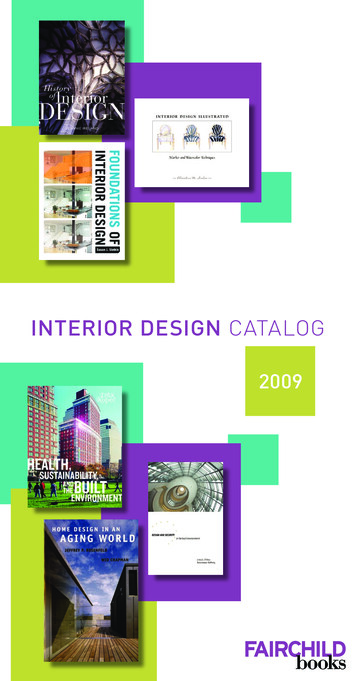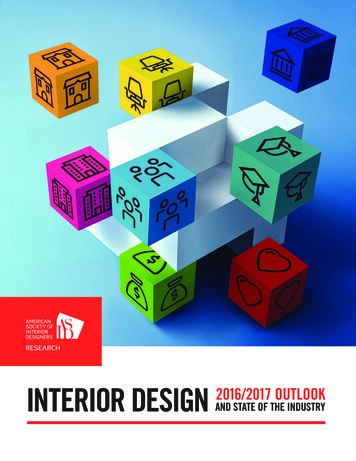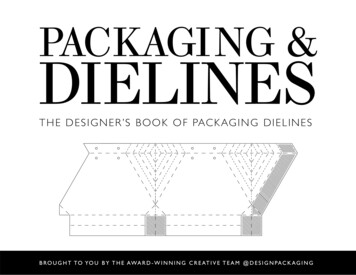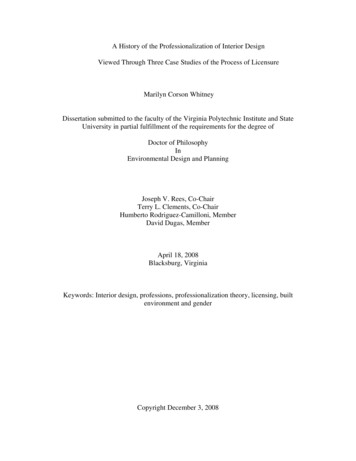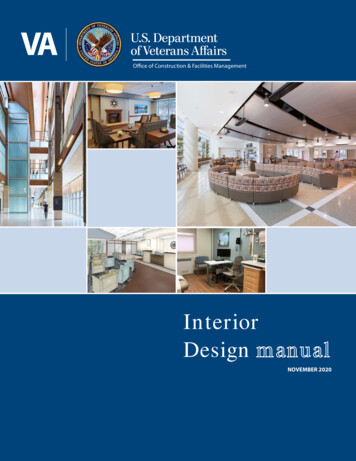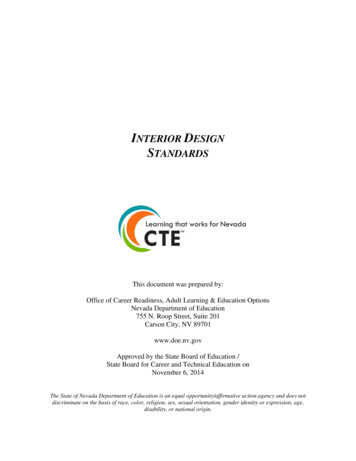
Transcription
INTERIOR DESIGNSTANDARDSThis document was prepared by:Office of Career Readiness, Adult Learning & Education OptionsNevada Department of Education755 N. Roop Street, Suite 201Carson City, NV 89701www.doe.nv.govApproved by the State Board of Education /State Board for Career and Technical Education onNovember 6, 2014The State of Nevada Department of Education is an equal opportunity/affirmative action agency and does notdiscriminate on the basis of race, color, religion, sex, sexual orientation, gender identity or expression, age,disability, or national origin.
INTERIOR DESIGN STANDARDS2014NEVADA STATE BOARD OF EDUCATIONNEVADA STATE BOARD FOR CAREER AND TECHNICAL EDUCATIONElaine Wynn. PresidentAllison Serafin .Vice PresidentDave Cook . MemberAlexis Gonzales-Black. MemberFreeman Holbrook . MemberTonia Holmes-Sutton . MemberTeri Jamin . MemberKevin Melcher . MemberMark Newburn . MemberJeff Zander . MemberKaylyn Taylor . Student RepresentativeNEVADA DEPARTMENT OF EDUCATIONDale A.R. ErquiagaSuperintendent of Public InstructionSteve Canavero, Ph.D.Deputy Superintendent for Student AchievementMichael J. Raponi, DirectorOffice of Career Readiness, Adult Learning & Education OptionsVISIONAll Nevadans ready for success in the 21st centuryMISSIONTo improve student achievement and educator effectiveness by ensuring opportunities,facilitating learning, and promoting excellenceReleased: 11/6/2014Nevada CTE Standardsiii
INTERIOR DESIGN STANDARDS2014TABLE OF CONTENTSNevada State Board of Education / Nevada Department of Education. iiiAcknowledgements / Standards Development Members / Business and Industry Validation /Project Coordinator . viiIntroduction . ixContent Standard 1.0 – Explore Careers and Professional Practices in Interior Design . 1Content Standard 2.0 – Explore Design Fundamentals . 2Content Standard 3.0 – Explore Influences that Affect Housing Choices . 6Content Standard 4.0 – Evaluate Residential Design. 7Content Standard 5.0 – Investigate Construction. 8Content Standard 6.0 – Explore Architecture . 9Content Standard 7.0 – Develop Planning Skills . 10Content Standard 8.0 – Evaluate the Selection of Furniture, Lighting, Appliances and Backgrounds . 12Content Standard 9.0 – Evaluate Commercial Design . 14Content Standard 10.0 – Analyze and Demonstrate Business Operations. 15Crosswalks and Alignments . 17Released: 11/6/2014Nevada CTE Standardsv
INTERIOR DESIGN STANDARDS2014ACKNOWLEDGEMENTSThe development of Nevada career and technical standards and assessments is a collaborative effortsponsored by the Office of Career Readiness, Adult Learning & Education Options at the Department ofEducation and the Career and Technical Education Consortium of States. The Department of Educationrelies on teachers and industry representatives who have the technical expertise and teaching experienceto develop standards and performance indicators that truly measure student skill attainment. Mostimportant, however, is recognition of the time, expertise and great diligence provided by the writing teammembers in developing the career and technical standards for Interior Design.STANDARDS DEVELOPMENT MEMBERSAlisa Sirat, InstructorSouthwest Career and Technical Academy,Las VegasShawn McNeace, Interior DesignerSRI Design Group, HendersonLVDC Design Salon DirectorSandra Jones, InstructorMineral High School, HawthorneLouAnn Sanoff, OwnerLMS Design Group, Las VegasJasmine Reuel, InstructorCentennial High School, Las VegasPeggy A. Scinta, Interior DesignerP. Scinta Designs, LLC, Las VegasJani Antrim, InstructorLas Vegas High School, Las VegasKelly Vogel, Interior DesignerVogel Designs, RenoAttila Lawrence, Professor of Interior DesignUniversity of Nevada, Las Vegas,Nancy Wolff, ASID, EducatorNV Registered Interior Designer ID05NCIDQ Certified # 13231Master Plan Interiors, Las VegasBUSINESS AND INDUSTRY VALIDATIONAll CTE standards developed through the Nevada Department of Education are validated by business andindustry through one or more of the following processes: (1) the standards are developed by a teamconsisting of business and industry representatives; or (2) a separate review panel was coordinated withindustry experts to ensure the standards include the proper content; or (3) the adoption of nationallyrecognized standards endorsed by business and industry.The Interior Design standards were validated through active participation of business and industryrepresentatives on the development team.PROJECT COORDINATORKaren Chessell, Education Programs ProfessionalFamily and Consumer SciencesEducation, Hospitality and Human ServicesOffice of Career Readiness, Adult Learning & Education OptionsNevada Department of EducationReleased: 11/6/2014Nevada CTE Standardsvii
INTERIOR DESIGN STANDARDS2014INTRODUCTIONThe standards in this document are designed to clearly state what the student should know and beable to do upon completion of an advanced high school Interior Design program. These standards aredesigned for a three-credit course sequence that prepares the student for a technical assessment directlyaligned to the standards.These exit-level standards are designed for the student to complete all standards through theircompletion of a program of study. These standards are intended to guide curriculum objectives for aprogram of study.The standards are organized as follows:Content Standards are general statements that identify major areas of knowledge,understanding, and the skills students are expected to learn in key subject and career areas by the end ofthe program.Performance Standards follow each content standard. Performance standards identify the morespecific components of each content standard and define the expected abilities of students within eachcontent standard.Performance Indicators are very specific criteria statements for determining whether a studentmeets the performance standard. Performance indicators may also be used as learning outcomes, whichteachers can identify as they plan their program learning objectives.The crosswalk and alignment section of the document shows where the performance indicatorssupport the Nevada Academic Content Standards in Science (based on the Next Generation ScienceStandards) and the English Language Arts and Mathematics (based on the Common Core StateStandards). Where correlation with an academic content standard exists, students in the Interior Designprogram perform learning activities that support, either directly or indirectly, achievement of theacademic content standards that are listed.All students are encouraged to participate in the career and technical student organization (CTSO)that relates to their program area. CTSOs are co-curricular national associations that directly enforcelearning in the CTE classroom through curriculum resources, competitive events, and leadershipdevelopment. CTSOs provide students the ability to apply academic and technical knowledge, developcommunication and teamwork skills, and cultivate leadership skills to ensure college and career readiness.The Employability Skills for Career Readiness identify the “soft skills” needed to be successful inall careers, and must be taught as an integrated component of all CTE course sequences. These standardsare available in a separate document.The Standards Reference Code is only used to identify or align performance indicators listed inthe standards to daily lesson plans, curriculum documents, or national standards.Program NameInterior DesignStandards Reference CodeIDExample: ID.2.3.4StandardsInterior DesignReleased: 11/6/2014Content Standard2Performance Standard3Nevada CTE StandardsPerformance Indicator4ix
INTERIOR DESIGN STANDARDSCONTENT STANDARD 1.0 :2014EXPLORE CAREERS AND PROFESSIONAL PRACTICESIN INTERIOR DESIGNPERFORMANCE STANDARD 1.1 : DESCRIBE THE HISTORY, CURRENT AND PROJECTED TRENDS INTHE INTERIOR DESIGN PROFESSION1.1.11.1.2Research current and projected trends with reference to professional standardsExamine historical trends in architecture, interiors, and furnishings (e.g., housing, museums,historical landmarks, etc.)PERFORMANCE STANDARD 1.2 : ANALYZE CAREER PATHS AND OPPORTUNITIES1.2.11.2.21.2.3Explore career opportunities in the interior design profession (e.g., residential, commercial,hospitality, retail, healthcare, merchandising, etc.)Determine preparation requirements for various areas of employment in interior designDetermine how interests, abilities, personal priorities and family responsibilities affect career choicePERFORMANCE STANDARD 1.3 : EXPLORE OPPORTUNITIES FOR ENTREPRENEURIAL ENDEAVORS1.3.11.3.21.3.31.3.41.3.5Describe the entrepreneurial opportunities in the interior design professionExplain the personal characteristics of a successful entrepreneurIdentify the advantages and disadvantages of owning a businessIdentify the components of a business planResearch the legal requirements and resources needed for starting a businessPERFORMANCE STANDARD 1.4 DEMONSTRATE AWARENESS OF REGISTRATION REQUIREMENTSFOR PROFESSIONAL ORGANIZATIONS1.4.11.4.21.4.31.4.4Describe the process for certification by the National Council of Interior Design (NCIDQ)Describe the registration requirements of Nevada State Board of Architecture, Interior Design andResidential Design (NSBAIDRD)Explore student and professional organizations associated with interior designParticipate in a student and/or professional organization functionPERFORMANCE STANDARD 1.5 : EXAMINE LOCAL, STATE, NATIONAL AND GLOBAL LEGISLATIONAND REGULATION1.5.11.5.21.5.3Differentiate between local, state, national and global economiesExamine the effects of the economic climate on the business of interior designReview legislation and regulation governing the professional practice of providing interior designservicesReleased: 11/6/2014Nevada CTE Standards1
2014INTERIOR DESIGN STANDARDSCONTENT STANDARD 2.0 :EXPLORE DESIGN FUNDAMENTALSPERFORMANCE STANDARD 2.1 : UTILIZE ELEMENTS OF uss the many meanings of the word design and how designers refer to designDescribe the three characteristics of design (i.e., function, construction and aesthetics)Explain and use the basic elements of design or “tools” used to create a design (i.e., line, shape,form, space, texture, pattern and color)Discuss color as an element of design (e.g., psychological, social, physical, etc.)Differentiate between shape and form (i.e., realistic, abstract, geometric and free)Investigate the use of space (i.e., positive and negative space) and mass (i.e., high and low)Discuss pattern, the application of color, lines, shapes and design to create visual interestProduce visual examples of each of the elements of design and explain their functionPERFORMANCE STANDARD 2.2 : ANALYZE COLOR AND ITS EFFECTS IN luate color characteristics (i.e., hue, value, tint, shade, tone, value scale, intensity, complement,neutrals and pigment)Analyze the relationships between colors on the color wheel (i.e., primary colors, secondary colorsand tertiary/intermediate colors)Discuss common color associations (e.g., pink for girls, blue for boys, green for envy, red for love,etc.)Discuss the use of color in different culturesDiscuss color organizations and color trend forecasters (e.g., Pantone, Color Marketing Group, ColorAssociation of the United States, etc.)Discuss the color spectrum (i.e., anatomy of color, visible light and the electromagnetic spectrum)Create an example of each of the color harmonies (i.e., monochromatic, analogous, triadic colorschemes, complementary, neutral, accented neutral, double-complementary and splitcomplementary)Discuss how choosing the right colors influences human behavior and affects health, mood, learning,lifestyle, and function of the roomNevada CTE StandardsReleased: 11/6/2014
INTERIOR DESIGN STANDARDS2014PERFORMANCE STANDARD 2.3 : INVESTIGATE TEXTILES FOR .82.3.92.3.10Communicate using appropriate textile terminology for production and construction (e.g., polymer,extrusion process, spinneret, tufted, needle punching, tanning, calendaring, railroading, napping, oneway design, warp, weft, wales, yarn, etc.)Compare and contrast synthetic and natural fibersAnalyze factors about fiber, yarn, and fabric manufacturing for use in textile products for residentialand commercial environments (e.g., processes for creating fibers, yarns, fabrics, performancecharacteristics, etc.)Identify different types of fabric (e.g., toile, chambray, chintz, corduroy, etc.)Evaluate textiles and finishes for quality constructionExplore fabric modifications in design (i.e., structural and applied), dyes (e.g., stock dyeing, solutiondyeing, yarn dyeing, piece dyeing, etc.), and finishesEvaluate characteristics of textiles for use and care in residential and commercial environments forflooring, upholstery, and window treatmentsDescribe the purpose of a fabric showroomSummarize the key features of textile consumer protection laws (e.g., Textile Fiber ProductsIdentification Act, Wool Products Labeling Act, Flammable Fabrics Act, etc.)Create a visual interest board with examples of textiles: including colors, prints, designs, texturesPERFORMANCE STANDARD 2.4 : UTILIZE THE PRINCIPLES OF DESIGN2.4.12.4.22.4.32.4.42.4.52.4.62.4.7Explain the basic principles of design or “the rules or guidelines of design” (i.e., proportion, scale,balance, rhythm, emphasis/focal point and harmony)Describe how proportion is the ratio/fraction of the parts to the whole and the conditions in whichproportion is used most effectively (e.g., the most effective ratios: Golden Mean; 2:3, Golden SectionRatio; 5:8, Golden Rectangle Ratio 1:1.618 and most ineffective 1:2, etc.)Discuss the relationship of scale to a design and to surrounding areas (AKA visual weight)Evaluate the types of balance and how they are used to create feelings in a room (i.e.,symmetrical/formal, asymmetrical/informal and radial balance)Demonstrate how focal point gives order and direction to a roomInvestigate examples of rhythm (i.e., repetition, gradation, radiation, opposition and transition)Produce visual examples of each of the principles of design and explain their functionReleased: 11/6/2014Nevada CTE Standards3
2014INTERIOR DESIGN STANDARDSPERFORMANCE STANDARD 2.5 : COMPARE AND CONTRAST ribe structural designDiscuss the meaning of “form follows function”Examine types of decorative design (i.e., naturalistic/realistic, conventional/stylized, geometric andabstract)Compare and contrast structural and decorative design together with the principles and elements ofdesign to form a solid base from which to judge any designRecognize the power of discernment and ways to train the eye (e.g., visit public buildings, walkthrough residential interiors, analyze the media, observe nature, seek education, etc.)Investigate ideas that appeal as a personal source of inspiration towards finding one’s uniquepersonal style (e.g., pare back, rearrange what you already have, think “need,” “not,” “want,”simplify and organize, cultivate creativity, personalize, cultivate good taste, etc.)Compare and contrast how the established styles of interior design form the basis for makingdecisions for a personal interior design style (e.g., Authentic historic/period styles, FormalTraditional, Informal Traditional/Colonial/or American Country, Informal European, CasualContemporary, Asian/Oriental, International Modern, Organic Modern/Craftsman Style/Arts andCrafts, Scandinavian Modern, Retro Modern, Contemporary Organic, Influences of Art Nouveau andArt Deco, Eclectic design, Thematic interior design, etc.)Compare and contrast two different styles of design for a specific roomPERFORMANCE STANDARD 2.6 : DEMONSTRATE PROFESSIONAL PRESENTATION 2.6.9Explore various methods of interior design presentationEvaluate the principles and elements of design in presentationsDevelop a resource file for a design plan (e.g., for inspiration, ideas, samples, etc.)Analyze professional lettering and labeling (e.g., block/architectural lettering, legends, keys, etc.)Demonstrate effective communication skills (e.g., interviewing, listening, paraphrasing, etc.)Demonstrate the elements of appropriate visual presentation (e.g., materials, finishes, color schemes,balance in positive and negative space, straight/squared edges, mounting, electronic/digital, etc.)Develop effective overall design concepts of visuals and samples (e.g., wall coverings, floortreatments, window treatments, furniture covering, renderings, pictures, visuals of the design:furniture, lighting, accessories, etc.)Gather and assess client information (e.g., characteristics, needs, wants, environment, atmosphere,ambiance, etc.)Determine that all measurements have been taken with the appropriate equipment and are accuratePERFORMANCE STANDARD 2.7 : DEVELOP AND WORK WITHIN A BUDGET TO CREATE A DESIGNPLAN2.7.12.7.22.7.32.7.42.7.54Research and compare costs for appropriate materials for backgrounds, furnishings, and accessories(e.g., retail stores, warehouses, discount stores, boutiques, markets and marts, suppliers, etc.)Analyze the cost of materials based on room measurementsDetermine preliminary budget (e.g., materials, supplies, furnishings, labor, fees, taxes, unexpectedcosts, revisions, etc.)Examine ways to maximize the budget (e.g., reuse, recycle, refurbish, etc.)Utilize appropriate tools to itemize a budget proposal, invoice, and timelineNevada CTE StandardsReleased: 11/6/2014
INTERIOR DESIGN STANDARDS2014PERFORMANCE STANDARD 2.8 : PRESENT A COMPLETED INTERIOR DESIGN PLAN2.8.12.8.22.8.32.8.42.8.5Utilize, where appropriate, perspective, pictorial drawing, rendering, overlay, sample boardIllustrate design ideas utilizing a variety of methods, (e.g., drawing, computer-aided drafting, etc.)Create professional presentations with all supporting materials (e.g., sample boards, computermodels, etc.)Perform a formal presentation of a completed design project for a simulated clientDescribe methods of addressing and resolving client objections and concernsReleased: 11/6/2014Nevada CTE Standards5
2014INTERIOR DESIGN STANDARDSCONTENT STANDARD 3.0 :EXPLORE INFLUENCES THAT AFFECT HOUSINGCHOICESPERFORMANCE STANDARD 3.1 : EVALUATE THE INFLUENCE OF NEEDS AND WANTS ON HOUSINGCHOICES3.1.13.1.23.1.3Compare and contrast needs as physical or psychological, (e.g., shelter, rest, food, safety, belonging,identity, creativity, etc.)Describe how housing affects quality of lifeDesign a space to fulfill needs and wants for individual, family and multi-generational livingPERFORMANCE STANDARD 3.2 : EVALUATE HOW LIFE CYCLE STAGES IMPACT HOUSINGCHOICES3.2.13.2.23.2.3Explore appropriate housing recommendations for each life cycle stageResearch factors about region, community and neighborhood home buying trends as they relate tochoosing housingEvaluate universal design housing features that meet the needs of all people, including those withspecial needsPERFORMANCE STANDARD 3.3 : ANALYZE THE IMPACT OF OTHER FACTORS ON HOUSINGCHOICES3.3.13.3.23.3.36Discuss how lifestyle, culture, values, and status relate to housing choicesResearch social trends and cultural influences and traditions that affect housingExamine the range of available options in housing designNevada CTE StandardsReleased: 11/6/2014
INTERIOR DESIGN STANDARDSCONTENT STANDARD 4.0 :2014EVALUATE RESIDENTIAL DESIGNPERFORMANCE STANDARD 4.1 : INVESTIGATE ALTERNATIVES IN RESIDENTIAL DESIGN4.1.14.1.24.1.34.1.44.1.54.1.6Explore different categories of residential living environments (e.g., single family, townhouse,apartment, condo, mobile home and future trends: container homes, small house, tiny homemovement, etc.)Analyze factors that impact housing decisions (e.g., location, climate, cost, lifestyle, availability,career, etc.)Compare and contrast custom, semi-custom and tract housingCompare and contrast the cost of remodeling versus new constructionEvaluate how The Principles of Universal Design are used in various residential options (e.g.,ageing in place, physical abilities, special needs, etc.)Explore sustainable environmentsReleased: 11/6/2014Nevada CTE Standards7
2014INTERIOR DESIGN STANDARDSCONTENT STANDARD 5.0 :INVESTIGATE CONSTRUCTIONPERFORMANCE STANDARD 5.1 : ANALYZE VARIOUS METHODS OF CONSTRUCTION5.1.15.1.25.1.35.1.45.1.5Compare and contrast various building materials (e.g., stucco, brick, hard surfaces, paneling, foam,etc.)Describe the roles of the developer, architect, contractor, subcontractor, and laborer in the homebuilding processDescribe the role of each component of the basic structure, (e.g., foundation, framing, walls, roof,windows, panel box, meter, septic tank, etc.)Recognize symbols used in architectural plansCompare and contrast different types of construction (i.e., conventional, modular and manufactured)PERFORMANCE STANDARD 5.2 : EXAMINE INTERIOR SYSTEMS5.2.15.2.25.2.3Describe the various interior environmental control systems used in housing, (i.e., plumbing,electrical, receptacle, thermostat, climate control, heating, ventilation and air conditioning (HVAC),lighting, communication, security, and automation or “smart home”)Recognize symbols used in architectural plansExplore new technology in housing systemsPERFORMANCE STANDARD 5.3 : ANALYZE ENERGY EFFICIENCY5.3.15.3.25.3.38Compare and contrast renewable and non-renewable energy resourcesDescribe the features of an energy-efficient structure (e.g., water conservation, alternative powersources, etc.)Describe ways to retrofit and/or modify a structure for energy efficiency (e.g., weather stripping,caulking, thermal doors and windows, full insulation, thermal blanket, etc.)Nevada CTE StandardsReleased: 11/6/2014
INTERIOR DESIGN STANDARDSCONTENT STANDARD 6.0 :2014EXPLORE ARCHITECTUREPERFORMANCE STANDARD 6.1 : IDENTIFY AMERICAN ADAPTATIONS ON ARCHITECTURAL DESIGN6.1.16.1.26.1.36.1.46.1.56.1.66.1.7Discuss how the characteristics of structures evolved as a result of historical events, culture, climate,resources, and technologyDescribe features derived from the early Native American, English, German, Dutch, Spanish,Swedish, and French homesIdentify architectural style (e.g., Log Cabin, Tudor, Spanish, Salt Box, Cape Cod, Georgian, Federal,Greek, Victorian, Prairie, Craftsman/Bungalow, Contemporary/Modern, Roman, etc.)Summarize the development of architectural styles throughout history, including Traditional (bothfolk and classic), Modern, and Contemporary house stylesDistinguish different styles of roofs, doors, windows, columns, moldings, stairways, porches,shutters, and other decorative elementsDiscuss the value of historical preservation and restorationExplore how design trends are revived from classic designsReleased: 11/6/2014Nevada CTE Standards9
2014INTERIOR DESIGN STANDARDSCONTENT STANDARD 7.0 :DEVELOP SPACE PLANNING SKILLSPERFORMANCE STANDARD 7.1 : DEMONSTRATE SPACE PLANNING7.1.17.1.27.1.37.1.47.1.5Examine the elements of a typical floor plan (i.e., symbols, scale and measurements)Examine the elements of a typical floor plan with furniture (i.e., activity zones, traffic patterns andfurniture arrangement)Demonstrate fundamental space planning techniques (e.g., understanding and accurately usingmeasuring equipment, conversions for scaling, etc.)Create a furniture plan based on a client’s needs and principles of design (e.g., activity, clearance,traffic zones, focal point, etc.)Produce a two-dimensional elevation (½” scale) of a focal point wall including full width and heightwalls, architectural details, furnishings, fixtures, and colorsPERFORMANCE STANDARD 7.2 : DEMONSTRATE FLOOR PLAN DEVELOPMENT AND velop a ¼” scale floor plan using appropriate symbols and toolsJustify placement of architectural details (e.g., window, fireplace, closets, electrical outlets, etc.)Develop a furniture arrangement to scale, utilizing furniture templates and ensuring adequatestandard clearance spacesDescribe the importance of computer-aided drafting and design in creating blueprints and floor plansDesign a floor plan with furniture using technologyCreate two different plans using the same floor plan and furniture templatesEvaluate how to select appropriate furnishings (i.e., steps: identify needs and wants, determinebudget, prioritize needs, identify lifestyle, identify personal style and determine preferences)Examine the use of multipurpose furniture (e.g., sofa bed for sitting or sleeping, highchair to a table,etc.) and unassembled furnitureNevada CTE StandardsReleased: 11/6/2014
INTERIOR DESIGN STANDARDS2014PERFORMANCE STANDARD 7.3 : EXPLORE SPACE PLANNING CONSIDERATIONS FOR 7.3.177.3.187.3.197.3.20Explore purposes and trends in residential spaces (i.e., hallways, entryways, foyers, and stairs;dining rooms, great rooms and libraries; bedrooms and master suites; children’s rooms; kitchens;outdoor living spaces, porches, patios, gazebos; laundry rooms; mud rooms, garages, closets,pantries, attics, crawl spaces and others)Evaluate designs for meeting needs, welcoming atmosphere, focal point, activity, lighting, electrical,ventilation, acoustics, formal vs. informal, circulation, transition space, storage, safety, security,maintenance, amenitiesCreate a scale model stairway that encourages an experience/fond memory while meeting budgetand space demands (e.g., grand staircase, glamorous entrance, a sense of home, etc.)Explore space planning for adjacent activities (e.g., kitchen near dining, dining near living, kitchennear barbeque, etc.)Produce a design plan for a preferred dining room size such as 10’x14’ (i.e., dining table seating forsix, hutch, corner cabinet, serving cart, lighting fixture and color scheme)Create a design for a bedroom, complete with a floorplan, color scheme, style, and furniturearrangementProduce a design for a master suiteDescribe how spare bedrooms are often used as home offices, studies, exercise rooms, craft/sewingspaces, guest roomsCreate age-appropriate room designs for children (i.e., infant, toddler, preschooler, school age andadolescent)Produce a design for an adolescent’s bedroom using a minimum of four considerations of needsPlan a bathroomExplore the different zones in kitchens and the work triangle (refrigerator, stove and clean-up sink)Describe the features of efficient kitchen design layouts (i.e., island, U-shaped, L-shaped, peninsula,single wall and galley/corridor)Explore standards and recommendations related to kitchen and bath design (e.g., Universal Design,National Kitchen and Bath Association, etc.)Plan a kitchen for a family of six, mother, father, teenager, two younger children and a grandparent,using The Principles of Universal DesignExplain measurement standards associated with kitchen cabinetry and appliancesProduce a design for a living and adjacent outdoor spaceRecommend storage solutions for each room in a floor planExplore standards and recommendations related to laundry areas (e.g., The Principles of UniversalDesign, National Kitchen and Bath Association, etc.)Produce a laundry room floor plan that includes lighting, flooring, storage, wash sink, line dryingand location in relationship to the rest of the facilityReleased: 11/6/2014Nevada CTE Standards11
2014INTERIOR DESIGN STANDARDSCONTENT STANDARD 8.0 :EVALUATE THE SELECTION OF FURNITURE,LIGHTING, APPLIANCES AND BACKGROUNDSPERFORMANCE STANDARD 8.1 : EVALUATE FURNITURE8.1.18.1.28.1.38.1.48.1.58.1.6Analyze a variety of furniture styles including early American, Chippendale, Queen Anne, French,Sheraton, Hepplewhite, Duncan Phife, Shaker, Victorian, Modern and ContemporaryIdentify furniture types (i.e., chairs, tables, upholstered pieces, case goods, soft and hard goods)Analyze various materials and techniques used in furniture constructionEvaluate a piece of furniture for quality constructionDesign and sketch a scale model quality piece of furniture and present it using a conceptpresentation drawing and mater
The Interior Design standards were validated through active participation business and industry of representatives on the development team. P ROJECT C OORDINATOR Karen Chessell, Education Programs Professional Family and Co




